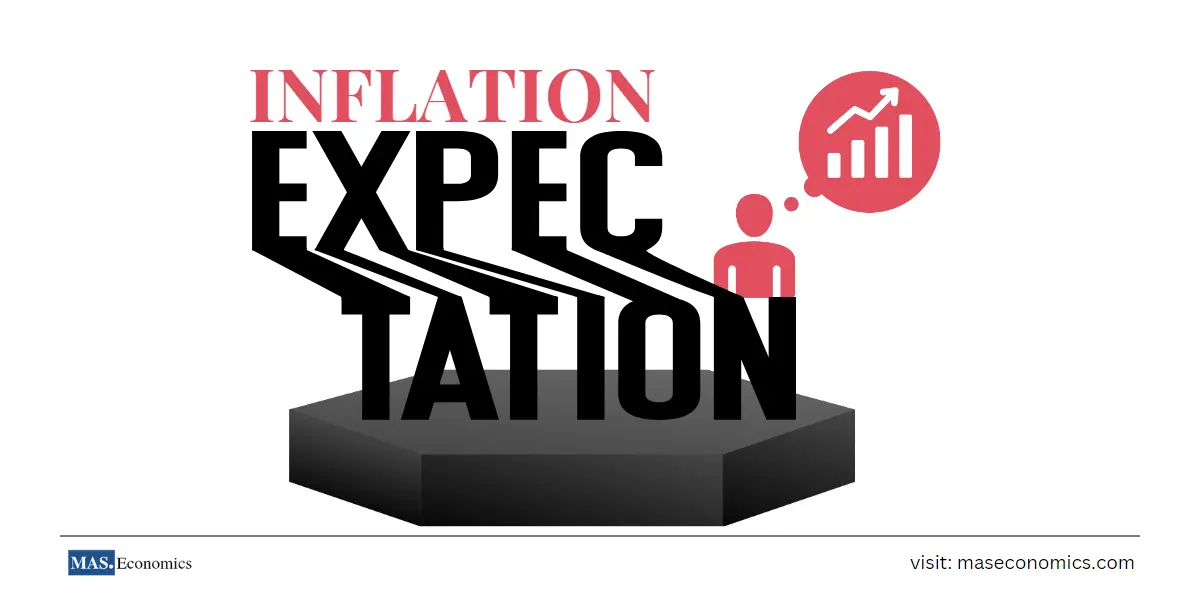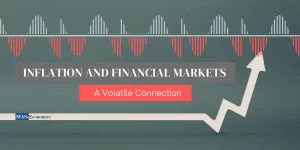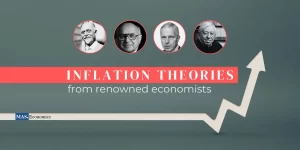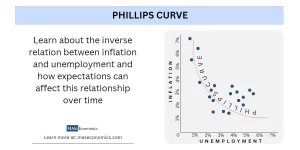Let us start by explaining,
What are Inflation Expectations?
Inflation expectations mean what people and businesses think will happen to the prices of goods and services they buy. Once prices start going up a lot, it can be hard to make them go back down again. If people expect prices to keep going up, that can lead to people asking for higher wages and companies having to pay more for things they need.
Why do Inflation Expectations matter?
Inflation expectations have a significant impact on the effectiveness of the monetary policy. When economic agents (people, businesses, institutions) have long-term inflation expectations closely aligned with a central bank’s inflation goal, that institution is more likely to succeed in keeping prices stable. Inflation expectations influence consumers’ current prices and wages, which can affect future inflation.
Since central banks must understand how inflation expectations are affected by different things, they must be aware of how external factors, domestic economic developments, and unconventional measures interact. By better understanding how these factors work together, central banks can develop more effective strategies for anchoring inflation expectations around their desired levels.
Measuring inflation expectations
Two common ways for measuring inflation expectations are Survey-based measures and market-based measures.
Survey-based measures
Two key sources of information are surveys of households, firms, and professional forecasters.
Surveys of households and firms
Surveys are used to assess households’ and firms’ expectations of inflation at various points in the future. Surveys provide valuable data that can help to inform economic decision-making. Several organizations around the world collect surveys to measure inflation expectations, including the University of Michigan’s Surveys of Consumers for the United States, the European Commission
Survey of professional forecasters
A Survey of professional forecasters, produced by Consensus Economics, is a vital barometer in gauging the direction of inflation. This survey incorporates the views and opinions of over 700 professional forecasters in 85 countries — ranging from advanced economies to emerging markets.
On average, households’ and firms’ inflation expectations are higher than those of professional forecasters, and the volatility of households’ inflation expectations is also much more significant. Such insights provide an invaluable tool for policymakers to ensure that potential price shifts are anticipated and managed efficiently.
Market-based measures
Inflation expectations are often measured through market-based measures, such as the break-even inflation rate and inflation swap rate.
break-even inflation rate
The break-even inflation rate is calculated by taking the difference between nominal bond yields and those of inflation-indexed bonds; however, it includes other elements besides expected inflation, making it imprecise.
Inflation swap rates
On the other hand, inflation swap rates are based on derivative instruments and are less affected by liquidity; however, they cannot be reliably extracted in some emerging markets due to a lack of developed markets.
Professional forecaster-based expectations tend to be closer to central bank forecasts, while survey design does not influence market-based measures. Ultimately, either measure can be used to understand inflation expectations. However, it is essential to understand their differences and any potential biases or limitations for policymakers to make informed decisions.
Limitations of Survey and Market based measures
Survey-based and market-based measures of inflation expectations are not necessarily higher or lower than one another, with professional forecasters’ estimates typically being close to the forecasts made by central banks. Professional forecasters tend to have lower levels of volatility in their expectations than those derived from markets. Break-even inflation rates can be volatile during financial stress due to flight-to-liquidity effects. The advantage of survey measures is that they are not affected by potential flaws in the survey design, while market-based measures reflect actual asset prices and trading activity. Therefore, survey and market-based measures should be studied when assessing inflation expectations.
Anchoring of inflation expectations
Inflation targeting is a robust monetary policy instrument central banks use to help manage inflation levels. A central bank can better control inflation and stabilize prices by setting an inflation target, leading to improved economic growth and development. Recent evidence suggests that when countries implement an inflation-targeting framework, the level of inflation declines significantly, and inflation expectations become better anchored. This is especially true in emerging markets and developing economies, where implementing an appropriate framework can positively impact economic outcomes. Nevertheless, central banks must be aware that there are limitations to using this approach and take other measures to promote price stability. Only with a well-anchored inflation expectation can countries achieve economic growth and development.
Roles of global and domestic shocks
Inflation expectations tremendously impact the global economy, and domestic and global shocks can influence their anchoring. According to recent studies, advanced economies have become less sensitive to external shocks since the 1990s, except for a significant drop during the 2008-2009 global financial crisis. Emerging markets, however, experienced a slight decrease in sensitivity to global shocks since 2000 and a gradual fall in sensitivity to domestic shocks between 2005-2012.
COVID-19 effect on the anchoring of inflation
The effects of the pandemic on economic shocks and unprecedented policy responses have raised questions about whether long-term inflation expectations (LTEs) remain anchored. The short- and long-horizon expectations for a selection of countries have risen with inflation but by varying degrees. Despite this, LTEs remain relatively insensitive to inflation, suggesting that progress in anchoring expectations has been maintained. The lack of disagreement among surveyed forecasters on long-term inflation is further evidence that expectations remain anchored. However, there are some early signs of de-anchoring, as reflected in the increase in disagreement on short-term expectations. Policymakers must remain vigilant to ensure that long-term inflation expectations remain anchored.
The main message from this analysis is that while short-term inflation expectations have risen following the surge in inflation, there are no signs of deanchoring so far. We thus conclude that the anchoring of long-term inflation expectations remains strong. This result is encouraging and suggests that inflation expectations are not drifting away from their pre-pandemic paths and therefore do not pose any risk to price stability. Going forward, central banks should remain vigilant to ensure that the current low inflationary environment remains stable.
News impact on Inflation Expectations
There has been a growing discrepancy between professional economists’ expectations of inflation and the public’s expectations. Researchers examined how people react to positive or negative news about inflation to understand why this is happening and how it affects the economy. The research revealed that when people hear good news, it helps to bridge the gap between professional and regular expectations. However, when people hear bad news, the gap widens.
Their analysis revealed that about one-quarter of the increase in average household inflation expectations from 2021 to 2022 was due to an increase in volume and negativity of inflation news coverage. This suggests that when the media focuses too much on negative stories about inflation, it can lead to an upward spiral of expectations and actual prices.
It is essential to be aware of how our perceptions of economic conditions can be influenced by news coverage. Knowing this, we should think carefully about what information we are hearing, who is delivering it, and how it is being communicated. This will help us better understand the economic dynamics and make more informed decisions about our financial situation.
Conclusion
Inflation expectations are a critical factor in the overall economy. They can be measured through surveys or by analyzing asset prices and trading activity. Inflation targeting is a robust monetary policy instrument central banks use to help manage inflation levels. Recent evidence suggests that when countries implement an inflation-targeting framework, the level of inflation declines significantly, and inflation expectations become better anchored.
Nevertheless, central banks must be aware of the limitations of using this approach and take other measures to promote price stability. Only with a well-anchored inflation expectation can countries achieve economic growth and development. The effects of the pandemic on economic shocks and unprecedented policy responses have raised questions about whether long-term inflation expectations (LTEs) remain anchored. However, central banks should remain vigilant to ensure that low current inflation rates remain stable. Only with a well-anchored inflation expectation can countries achieve economic growth and development.




